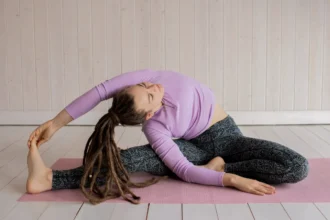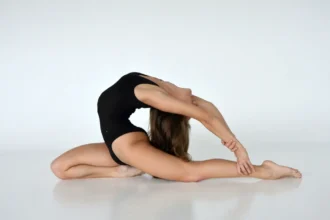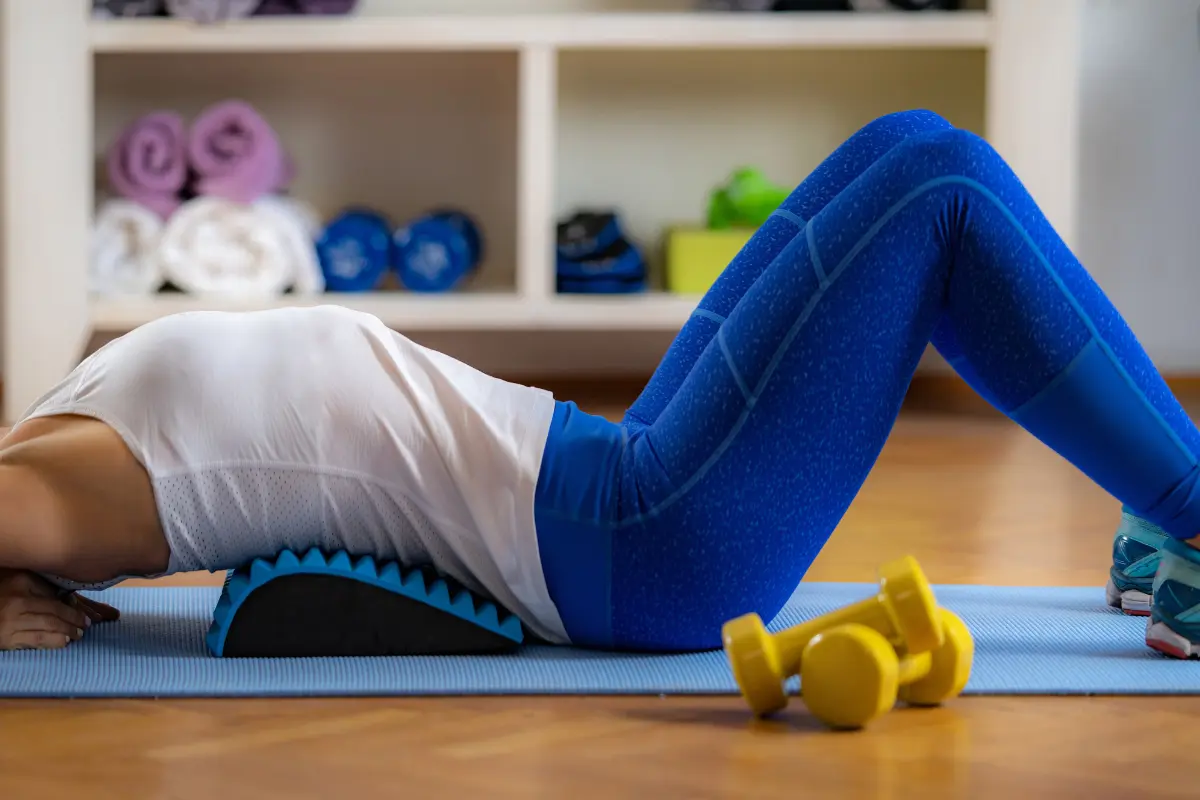Today, we’ll go through a simple yet powerful daily stretch routine from Anna McNulty to help you get a flexible back fast. Whether you’re a beginner or very advanced, these stretches will help improve your back flexibility.
1. Warming Up
We’ll start with some basic reaching and stretching exercises to wake up our muscles and gently improve flexibility. These moves will help lengthen our spine, engage our core, and loosen up any tight spots.
1) Reach Up and Forward
Let’s start by reaching up high towards the ceiling. Feel the stretch in your entire body as you elongate your spine. Then, slowly bend forward into a flat back position. As you bend, focus on pulling your arms forward and pushing your hips back to fully lengthen your torso.
Keep your back as flat as possible and reach your hands as close to the ground as you can. This initial stretch is crucial for warming up your back and preparing it for deeper stretches.
2) Reaching for Your Feet
Next, transition to reaching your hands as close to your feet as possible. Make sure to maintain a straight back and avoid curving your spine. It’s better to not reach as close to your feet if it means keeping your back straight.
If you can easily touch the ground, bend your arms slightly for a deeper stretch. This will help in elongating your hamstrings and further stretching your back muscles.
2. Back Bends
Back bends are a type of exercise and stretch that involves arching the spine backwards, enhancing flexibility, and strengthening the back muscles. They are widely used in yoga, gymnastics, and other fitness routines to improve spinal mobility, posture, and overall body strength.
Don’t worry if you can’t do a full back bend yet – there are modifications for every level. Follow this step-by-step guide to safely perform back bends, incorporating breaks and variations to suit your skill level.
Step 1: Initial Back Bend
- Position Yourself: Stand up straight with feet hip-width apart.
- Roll Down: Slowly roll down, vertebra by vertebra, until your hands touch the floor (or as close as you can get).
- Transition: Once your hands are on the floor, gradually walk them back towards your feet while lifting your hips towards the ceiling to enter a back bend (bridge position).
- Hold: Stay in this position for 10-15 seconds, focusing on breathing deeply.
Step 2: Rest and Prepare for Leg Lifts
- Come Out of the Back Bend: Slowly walk your hands back towards your feet and gently roll up to a standing position.
- Take a Break: Rest for 10-15 seconds. Shake out your arms and legs to release any tension.
Step 3: Back Bend with Leg Lifts
- Push Back Up: Transition back into the back bend position.
- Lift One Leg: Gradually lift one leg off the ground, maintaining balance and keeping your core engaged.
- Hold and Switch: Hold the position for 5-10 seconds, then bring the leg down and lift the opposite leg. Hold again for 5-10 seconds.
- Rest: Come out of the back bend and take another short break, shaking out any tension.
Step 4: Elbow Back Bend
- Push Back Up: Move back into your back bend position.
- Lower to Elbows: Slowly lower your forearms to the ground, ensuring your elbows are aligned under your shoulders.
- Deepen the Stretch: Hold this deeper back bend for 10-15 seconds.
- Modification Option: If lowering to your elbows is too difficult, continue holding the regular back bend or use a wall for support.
Step 5: Transition to Forward Stretch
- Downward Dog: From the back bend, carefully transition into the downward dog position by lifting your hips and straightening your arms and legs.
- Hold the Pose: Hold the downward dog for 15-20 seconds, focusing on stretching your back and hamstrings.
Step 6: Stomach Stretch
- Lay Down: From downward dog, gently lower your body to the ground and lie on your stomach.
- Straighten Arms and Arch Back: Place your hands under your shoulders and straighten your arms, arching your back into the Cobra Pose.
- Hold: Maintain the position for 15-20 seconds, feeling the stretch in your lower back.
3. Child’s Pose
Child’s Pose, or “Balasana” in Sanskrit, is a resting yoga pose that helps stretch the back, hips, and shoulders. It’s an excellent pose for beginners due to its simplicity and the comfort it provides.
How to Perform Child’s Pose
1) Start on Hands and Knees: Begin in a tabletop position with your wrists directly under your shoulders and your knees under your hips.
2) Sit Back on Your Heels: Slowly sit back on your heels, spreading your knees apart if comfortable, or keeping them together for a different variation.
3) Extend Your Arms Forward: Reach your arms forward, extending them in front of you. Alternatively, you can place your arms by your sides with palms facing up for a more restful position.
4) Rest Your Forehead on the Mat: Lower your forehead to the mat, allowing your neck to relax completely. If your forehead doesn’t comfortably reach the mat, you can rest it on a block or cushion.
5) Lift Your Hips (Variation): For an enhanced stretch in your shoulders and back, you can lift your hips slightly off your heels while extending your arms forward.
6) Hold and Breathe: Hold the pose for several breaths, focusing on deep, steady breathing. Feel the stretch along your spine, shoulders, and hips.
Transition and Deeper Stretch Options
From Child’s Pose to Stomach Stretch: After holding Child’s Pose, transition by coming back onto your stomach. Extend your arms and lift your chest into a gentle backbend, such as Cobra Pose, to stretch the front of your body.
Ankle Grab for Deeper Stretch: While on your stomach, reach back to grab your ankles. If you don’t feel a stretch just reaching for your ankles, straighten your legs for an even deeper stretch. This is known as Bow Pose (Dhanurasana).
Hands and Knees Transition: After completing the stretches, return to your hands and knees to reset your posture before moving on to the next pose.
3. Knee Back Bend
The knee back bend begins from a kneeling position and progresses by arching the back and reaching either back or overhead, depending on the practitioner’s flexibility and strength.
This pose can be modified to suit beginners and can be intensified for advanced practitioners by increasing the depth of the arch and range of motion.
How to Perform a Knee Back Bend
1. Preparation and Initial Stretch
- Start on Hands and Knees: Begin in a tabletop position with your wrists directly under your shoulders and knees under your hips.
- Kneeling Position: Rise up to a kneeling position with your knees hip-width apart.
2. Beginner’s Knee Back Bend
- Arch Back: If you are a beginner, simply place your hands on your lower back for support and gently arch your back, lifting your chest towards the ceiling.
- Hold and Breathe: Hold the arch for a few breaths, focusing on lengthening through the spine.
3. Intermediate Knee Back Bend
- Reach Overhead: For a deeper stretch, reach your arms overhead as you arch back, creating a more pronounced curve in your spine.
- Maintain Balance: Keep your core engaged to support your lower back and maintain balance.
4. Advanced Knee Back Bend
- Full Knee Back Bend: Advanced practitioners can progress to reaching back with their hands to touch their heels. Ensure your hips remain aligned over your knees and continue to lift your chest.
- Triple Fold (Advanced Option): Very advanced practitioners might push their head through and create an even deeper arch, known as the triple fold. This variation should only be attempted if you are confident in your back flexibility and strength to avoid injury.
5. Exiting the Pose and Transitioning
- Return to Neutral: Carefully come out of the back bend by bringing your torso upright, one vertebra at a time, to avoid strain.
- Child’s Pose: Transition into Child’s Pose to relax and stretch out your back. Sit back on your heels with your arms extended forward, forehead resting on the mat, and breathe deeply.
Final Thought
This routine isn’t just about physical flexibility; it also helps reduce stress and promotes a sense of well-being.
Starting with gentle warm-ups and progressing to deeper stretches like back bends and knee back bends, this routine caters to all levels, from beginners to advanced practitioners. Adding stretches like Downward Dog and Child’s Pose in between helps balance your routine and provides much-needed relaxation.
Keep stretching, stay consistent, and enjoy the journey to a more flexible and healthier back.





